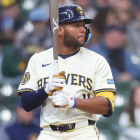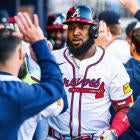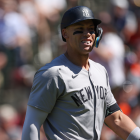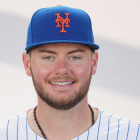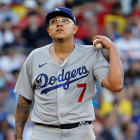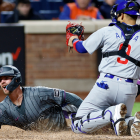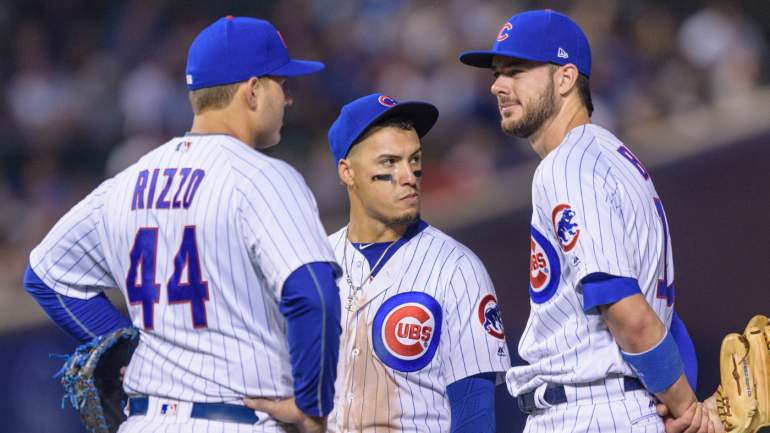
With some other franchises, this wouldn't be the case, but we're talking about the Chicago Cubs. They are technically still in the midst of the best run of success in franchise history. I suppose an argument could be made for 1906-10, but there are so many more teams now and the game is so different it's not even worth comparing.
Seriously, though, take a look at the Cubs on a season-by-season basis before the 2015 season. You'll see zero postseason appearances between 1945 and 1984. You'll find six playoff appearances from 1984-2014, a stretch that included three trips to the NLCS, but only one series win (the 2003 NLDS). In all, there were nine playoff game wins with six of them coming in 2003, a postseason that included their most notorious choke job.
Since the start of 2015, though, the Cubs have been to the playoffs five times in six years with three division titles. They have three trips to the NLCS, their first pennant since 1945 and first World Series title since 1908. There were six "series" wins (including the 2015 wild card game) and 19 playoff game victories in all. They haven't had a losing record since 2014, the longest stretch without a sub-.500 record since 1967-72. It truly is the golden era of Cubs baseball.
But.
Oh man, that word? Yeah. The 2015 deep run and 2016 title raised expectations and with such a young and exciting roster -- at least position-player-wise -- people were talking dynasty. The Cubs did have a huge second half in 2017 and beat the Nats in the NLDS, but since then, they've gone 1-7 in playoff games and that doesn't include losing the one-game playoff for the NL Central title to the Brewers in 2018. It does include a two-game sweep at the hands of the Marlins in the wild-card round last year in which the Cubs' offense mustered one run (a solo home run) in 18 innings.
The 13-3 start vs. the rest of the season and the ensuing postseason flop was a bit of a microcosm for how the golden era here has gone. There was so much hope and they did get the one title, but after that it was nothing more than a tease.
We'll discuss this more toward the end of this preview, but this season is very likely the end of the road for the lingering vestiges of the championship core.
On that totally sunny note, let's preview the 2021 Cubs.
Win total projection, odds
- 2021 SportsLine projection: 86-76
- World Series odds (via William Hill Sportsbook): +4000
- 2020 Record: 34-26 (won NL Central, swept by Marlins in wild card round)
Projected Lineup
- Ian Happ, CF
- Anthony Rizzo, 1B
- Kris Bryant, 3B
- Joc Pederson, LF
- Javier Baez, SS
- Willson Contreras, C
- Jason Heyward, RF
- Nico Hoerner, 2B
Bench: C Austin Romine, IF David Bote, IF Ildemaro Vargas, IF Eric Sogard, OF Jake Marisnick
It's still possible Bote takes the everyday job at second base and that Hoerner is sent to Triple-A to get some seasoning. He's only played in 89 minor-league games and none of them came at Triple-A while he's hit just .247/.309/.333 at the big-league level in 207 plate appearances. Of course, he's killing the ball in the spring in what is the Cubs only position battle and the Triple-A season is being delayed, so they have little reason to make him sit around and wait.
Play around with 2-6 in the batting order however you want. It's likely David Ross does the same on a daily basis until/if things settle in. The only sure thing is they won't hit the lefties Rizzo and Pederson back-to-back or in the six-hole next to fellow lefty Heyward.
Speaking of Pederson, he's never really been allowed to face lefties on a regular basis (he has 2,132 plate appearances against right-handed pitching and 385 against southpaws), but he's hit just .191/.266/.310 when he has. The Cubs have decided to let him go full time. It'll be interesting to see how it works out.
Projected rotation, bullpen
- Kyle Hendricks, RHP
- Zach Davies, RHP
- Alec Mills, RHP
- Jake Arrieta, RHP
- Adbert Alzolay, RHP
Bullpen: CL Craig Kimbrel, SU Rowan Wick, SU Ryan Tepera, LHP Andrew Chafin, LHP Kyle Ryan, MR Brandon Workman, MR Jason Adam, MR Dan Winkler
Trevor Williams in the rotation is a distinct possibility and the Cubs have even discussed doing something advanced with him and/or Alzolay, such as using an opener or just having them face the order one time or maybe a strict two-times-through edict. Regardless, there are actually six starters fully on the radar. Or seven? Shelby Miller has been impressing scouts in camp.
As for Kimbrel, his two years with the Cubs include some high-profile meltdowns and awful numbers (6.00 ERA, 1.53 WHIP), but something seemed to shake loose late in 2020. In his last 14 appearances (he only made 18 total, so this just lops off his first four), he had a 1.42 ERA with 26 strikeouts in 12 2/3 innings. Walks had previously been a problem, but in September, he struck out 13 in 7 1/3 innings without issuing a single walk. He didn't allow an extra-base hit, either, holding opposing hitters to a tidy .125/.125/.125 line. If he really did get fixed, the bullpen won't be a problem at all.
Here are three questions about the Cubs' 2021 season.
Can the soft-tossing rotation work?
Leaving out whatever happens with the fifth spot, the top four of the Cubs' rotation is a total throwback in terms of fastball velocity and putting the emphasis on defense. Crash Davis would be proud.
Of 209 qualified pitchers in 2020, here are where the Cubs' top four starters ranked in average fastball velocity:
- Jake Arrieta, 91.9 mph, 141st
- Alec Mills, 89.8 mph, 181st
- Zach Davies, 88.4 mph, 191st
- Kyle Hendricks, 87.4 mph, 197th
Only Davies came even close to averaging a strikeout per inning (8.2 K/9; Hendricks was second at 7.1), which means an overwhelming majority of outs are going to come via the defense. Many people will like the aesthetics!
This puts the spotlight on the Cubs' defenders, of course, and they'll likely be up to the task. The Cubs ranked fifth in baseball last season in defensive efficiency. The infield has the chance to be excellent with Rizzo and Baez capable of elite-tier glovework; Hoerner, too, if he wins the job. Bryant is perfectly capable of above-average work as well. Heyward isn't other-worldly in right anymore, but he's still well above average. Happ and Pederson don't figure to be great, but Marisnick as a late-inning center fielder pushing Happ to left is a game-changer. Contreras has a cannon behind the plate and really stepped up his framing game last year, too. A Contreras-Rizzo-Hoerner-Bryant-Baez-Happ-Marisnick-Heyward alignment is enough to help any Cubs pitcher sleep very peacefully at night.
Defensive efficiency measures the percentage of balls put in play that are converted into outs. The Cubs need to be toward the top of that leaderboard -- the talent on hand says they will be -- because their rotation doesn't figure to keep many balls out of play.
2. An offensive rebound?
So many times these past few seasons, I've found myself looking at the Cubs' lineup and hearing Brad Pitt as Billy Beane wondering, "if he's a good hitter, why doesn't he hit good?" The personnel just feels like it is constantly underachieving. During parts of 2017-19 under Joe Maddon it seemed like maybe the culprit was his constant tinkering and changes in approach from different hitting coaches. Perhaps the pandemic changes affected things last season. Or maybe we're just coming up with excuses and they aren't as good as many thought. Regardless, here is where the team ranked last season in major offensive categories among baseball's 30 teams:
- Batting average: 27th (.220; yes, the entire team hit .220)
- On-base percentage: 18th
- Slugging percentage: 24th
- Runs: 20th
- Home runs: 17th
- Strikeouts: 5th
There it is, right? The excessive strikeouts and low batting average are the killers. Those get better and everything else comes along for the ride.
Will subbing out Kyle Schwarber for Pederson help? It's entirely possible. Schwarber was bad last season. Internal improvement could very well happen from several spots, too.
- Contreras had essentially the same OBP as 2019, but he lost 29 points of average and 126 of slugging from 2019 to 2020. He's still in his prime.
- From 2014-19, few players were more consistent than Rizzo. He hit .284/.388/.513 in those years. Last season it was .222/.342/.414.
- In 2018-19, Baez became a star and hit a combined a .286 average with a .544 slugging. Last year he hit .203 with a .360 slug. He's openly discussed how the lack of in-game video and fans affected him. Both return in 2021.
- Bryant went from 2019's .282/.382/.521 slash to .206/.293/.351. He was banged up. Again.
- The Happ gains certainly seem real and did anyone else notice Heyward's productive offensive season (129 OPS+)?
There's enough talent here to see a pretty potent offense. There's also enough for us to collectively wonder why the so-called good hitters don't hit good.
3. The end for this core?
The championship core has slowly been dwindling these last few years. Two big guys from the 2016 World Series left again this past offseason, with Jon Lester and Kyle Schwarber both heading to D.C. as free agents. If there's been a "core four" among position players these last several years, it's Rizzo, Bryant, Baez and Contreras. Well, Rizzo, Bryant and Baez are set to hit free agency after this season. Contreras is up after 2022.
We can't be sure of much here, but it's pretty clear that there's about a zero percent chance the Cubs extend all four. I'm very confident they won't extend even three of them. Two? Eh. Maybe Rizzo and/or Baez, but I wouldn't be betting on both.
The easy thing for club president Jed Hoyer would probably be for the team to fall out of contention in the first few months of the season. Then he could justify trading all four in order to restock the upper levels of the minors while looking ahead to a possibly-huge offseason. In this case, the Cubs would only have around $90 million on the books for 2022 while staring at a prolific free agency class. They'd again have the shot to be major players.
What if they are strong contenders in a weak NL Central, though? He surely can't justify bailing on the incredibly popular foursome that has already brought a championship to Wrigleyville. They don't have a ton of trade-able prospects to shore up any holes as "buyers," either.
For those who love trade deadline chatter, the Cubs are one of the biggest teams to watch in baseball.
Regardless, the 2016 World Series champs might have just Kyle Hendricks and Jason Heyward left at season's end. If that's the case, it'll be such a disappointing conclusion to the saga that included the highest high Cubs fans have ever had.
There's also enough good here to believe there's a chance -- however remote -- at one last deep playoff run.















